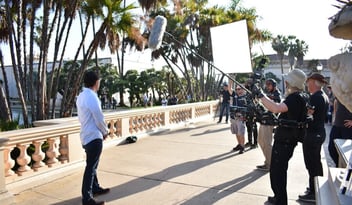Videoconferencing for AV production all boils down to preparation. When the presenter(s) arrive, it's time to coach them on best practices, not fiddle around with technology!
Videoconferencing: What's the Big Deal?
Wait, what about that camera in the video conference room? Videoconferencing is a fact of life in the professional world. The time and money saved by not traveling makes it a preferred meeting method and most large organizations have already made the upfront investment in hardware and infrastructure with an eye towards those savings and increased agility. A benefit for those of us in corporate communications is that the same infrastructure can be leveraged for a variety of internal media production initiatives: training videos, internal webcasts and organization-wide Q&A sessions. Rather than hiring and transporting a video production crew to a remote office, a presenter can simply walk into their local video conference room with minimal set-up time and speak live to their audience or make a recording for later use. Ah, but what about that minimal set-up time? It's easy to tell when something is going wrong during a videoconference, but how about a list of things to do in advance to avoid problems? Here's what I do to make sure I actually get some set-up time, and how I take advantage of it:
How Should I Prepare for a Videoconference or AV Production?
Before the conference:
Before the conference, it's important to meet with stakeholders in advance to work out logistics. Go through the list below and make sure each step is accounted for.
- Finalize all the details about which rooms will be involved, numbers to dial and who will be in each room.
- Agree to start the conference early with a delegate in each room that is to be involved. Each delegate will facilitate making any adjustments in their local room that can improve audio and video quality.
- Agree to have presenters come to the rooms 15 minutes early to receive some coaching on best practices during the videoconference. Advise that those who will be on-camera should wear neutral or pastel colors and avoid wearing white, black, red or tight patterns that don't 'play' well with video.
- Give advice on formatting any materials to be presented: Slides should favor bullet points with large clear fonts. Videos should be short and to the point to keep the audience's attention from drifting to other tasks.
Day of the conference:
When the day arrives, it's time to connect early and run through a punch list with your in-room delegates to make sure people look and sound their best without getting distracted during the actual conference.
- Make sure all lights in the room are turned on.
- If there are windows, closing the drapes or blinds will give more consistent lighting.
- Identify location of microphones in the room, tap each to make sure it is working. Speak near each microphone to identify any that are marginal and should be avoided (avoid placing presenters near them.)
- Decide where speakers should sit in each room so that they can be clearly heard and seen.
- Have a delegate sit in speaker positions and try adjusting lighting to prevent forehead glare or other distractions.
- Adjust camera zoom and focus for the best shot of the presenter positions.
- Confirm that each site connected can hear and see all of the other sites.
- Connect the presentation laptop and confirm that any materials to be presented are working as expected.
- Clean up' the visible part of each room: push in chars, toss leftover papers and organize items on tables and in the background.
When the presenters arrive:
When the presenter(s) arrive it's time to coach them on best practices. Each presenter will sound, look and present differently from another. There are several components to consider once your presenters arrive.
- Look at the camera periodically. An occasional glance is enough to keep a feeling of connection to the audience.
- Don't block the microphone with an open laptop, move it to the side if necessary.
- Don’t be afraid to use gestures to emphasize a point (but stop short of pounding a shoe on the table.)
- Avoid 'double talk' when having a dialogue with other rooms: there can be a slight delay in response that can cause people to talk over each other. Wait a little longer then what seems natural for responses before speaking.
- Last minute wardrobe changes: If a presenter "didn’t get the memo" and arrives in a pinstriped shirt, it's not too late to ask politely if they can change or wear a jacket or sweater to cover it.
After the conference:
Your conference has come to a close, but you still have a few tasks to complete to help improve future events and productions. Here's what you should consider!- Thank your presenters and especially the delegates who helped with room set up.
- Be sure to report any tech issues you noticed (such as intermittent laptop cables or bad mics) to your video conference team or room owners so that repairs can be made.
- Take some notes about positive and negative aspects of each room for reference when choosing rooms in the future.
Working through these points won’t turn a videoconference into a replacement for a full on-site production crew, but you will end up with the best quality communication using the tools that are available. Your audience and your clients will thank you for the extra care taken to get and use that minimal set-up time.
TeamPeople is a media staffing company. We work with clients ranging from Fortune 500 corporations to government agencies to recruit, hire and manage creative and technical media production and AV talent. We combine extensive industry expertise with a passion for what we do to deliver best-in-class solutions for our diverse clients.


